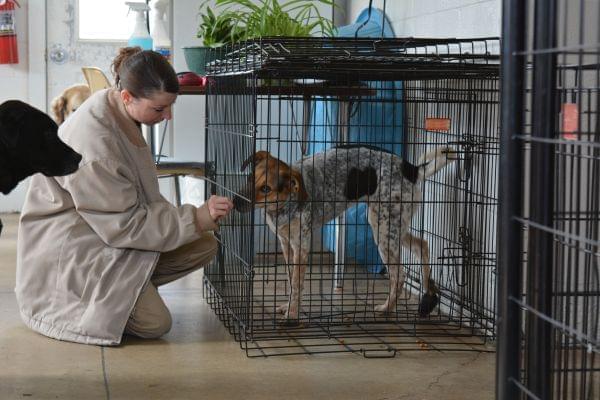ADOPT Program Helps Inmates And The Dogs They Train

Amber Lace with one of the dogs in the ADOPT program at the Rockville Womens Correctional Facility. . Kaitlin Bane/WILL
According to estimates from the federal Bureau of Justice Statistics, a vast majority of those released from state prisons end up back behind bars within five years. Many facilities now offer educational and vocational programs to end that cycle, including one prison just across the border in Indiana.
Amber Lace has been at the Rockville Woman’s Correctional Facility in Indiana for thirteen years. She’s serving time for murder.
“You know a lot of us girls that are here were beaten down," she says. "We’ve lived horrible lives and not a lot of good things have happened.”
According to court records she was part of a group that killed a drug dealer they were robbing. She still has ten years left on her 23-year sentence and has found a way to deal with prison life and prepare her for when she gets out.
“I don’t know how I could do my time here without being in the program. It helps me,” she says.
Lace is a handler in the prison’s ADOPT program, which pairs dogs from an Indiana animal shelter with inmates who train them in basic obedience skills. She says it gives her something to look forward to every day.
“It makes me feel good," she says. "It makes me feel like I am actually doing something good.”
Janine Ostrum manages the Parke-Vermillion county animal shelter that partners with the prison on the ADOPT program. She says the program helps more than just the inmates. The dogs benefit, too.
“A lot of dogs that come into the shelter as strays or maybe didn’t get the type of training they should have had in their home, they get that training at the adopt program, which makes them much more adoptable,” she says.
The women work with their dogs every day, training, grooming and cleaning up after the animals. Sherry White manages the ADOPT program and says after 36-hundred hours of work with the dogs and some additional classroom time, the women are awarded a Department of Labor certificate in animal husbandry.
“They have to earn every single hour they get and it’s a rough two years for them, it’s not easy,” White says.
This program is not the only one of its kind. About 36 U.S. states have some type of prison program that involves animals. In 2007, a study published from the University of Illinois at Chicago found that these types of programs improve inmates' ability to better communicate with others and their understanding of appropriate social behaviors.
Inmate Amber Lace says that’s the hardest part of the program. "It’s learning how to live with others, learning how to work with others.”
“We’re all women and personalities clash sometimes," she says. "So if one person’s having a bad day, you know, it can just set the mood and make it kind of rough to be around.”
At one point, Lace had to leave the program because of behavior problems. White says she pulled her aside and showed her what would happen if that didn’t change.
“I would set up scenarios where I would take her into the visiting center and I would put her on one side, there’s a non-contact room, and say, pick up the phone and talk to me because this is how you are going to be talking to your kids if you keep it up.”
Before Lace could return to the program, she had to prove to White that she was ready for the responsibility again.
Lace knows she’s making a difference thorough the program and she says that’s a good feeling.
“Me personally I’ve done a lot of wrong in my life and this gives me a chance to make it right. It gives me a chance to look at, I’m doing something positive,” she says.
Though she knows she is doing good, Lace says one of the biggest struggles is saying goodbye to the dogs. Especially Georgie, a deaf boxer she taught to respond to sign language.
“Everything that he did he looked toward me. So he relied on me 100 percent, all the time. Everywhere I went he went with me. I was his ears for everything. He looked to me for any answer that he needed, he looked to me," Lace says. "So it was heart wrenching when he had to leave.”
But she knows the dogs are going to a happier life.
“They’re going to go to their forever home, we know that they’re finally going to get to be happy, they’re finally going to get to be free. So it feels good, it really feels good.”
While each dog spends about three months in training at the facility, most have adoptions lined up before they graduate.
